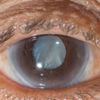COMPUTER VISION SYNDROME
SYMPTOMS OF COMPUTER VISION SYNDROME
Commonly experienced symptoms of Computer vision syndrome can be sub-divided into three mechanisms namely;
- Extraocular Mechanism (Extraocular means outside the eyes).
- Ocular Surface Mechanism (Ocular or Intraocular means inside the eye).
- Accommodative Mechanism Related.
Commonly experienced symptoms of Computer vision syndrome can be sub-divided into three mechanisms namely;
| Mechanism | Symptoms |
| Extraocular | Neck stiffness
Neck pain Shoulder pain Headache Backache |
| Ocular surface | Tearing
Gritty Dryness Redness Gritty Sensation Burning Contact lens-related problem |
| Accommodative mechanism Related | Blurring of vision
Double vision Presbyopia Myopia |
Extraocular mechanism causes symptoms such as neck stiffness, pain, headache, backache, and shoulder pain. These symptoms are well associated with improper placement of computer screen which leads to muscle sprain.
Accommodative mechanism causes blurring of vision, double vision, presbyopia, myopia, and slowness of focus change.
Ocular surface mechanism causes symptoms such as dryness of the eyes, redness, gritty sensation and burning after an extended period of computer usage.
These symptoms may be multifactorial, among the common factors found to be related to dryness are reduction in blink rate, reduction of tear production due to aging process contact lens usage, etc.
These symptoms may also be caused by:
- poor lighting
- glare on a digital screen
- improper viewing distances
- poor seating posture
- uncorrected vision problems
- a combination of these factors
Viewing a computer or digital screen often makes the eyes work harder. As a result, the unique characteristics and high visual demands of computer and digital screen device viewing make many individuals susceptible to the development of vision-related symptoms.Uncorrected vision problems can increase the severity of Computer Vision Syndrome or Digital Eye Strain symptoms.
Viewing a computer or digital screen is different than reading a printed page. Often the letters on the computer or handheld device are not as precise or sharply defined, the level of contrast of the letters to the background is reduced, and the presence of glare and reflections on the screen may make viewing difficult.
Viewing distances and angles used for this type of work are also often different from those commonly used for other reading or writing tasks. As a result, the eye focusing and eye movement requirements for digital screen viewing can place additional demands on the visual system.
In addition, the presence of even minor vision problems can often significantly affect comfort and performance at a computer or while using other digital screen devices. Uncorrected or under corrected vision problems can be major contributing factors to computer-related eyestrain.
Even people who have an eyeglass or contact lens prescription may find it’s not suitable for the specific viewing distances of their computer screen. Some people tilt their heads at odd angles because their glasses aren’t designed for looking at a computer. Or they bend toward the screen in order to see it clearly. Their postures can result in muscle spasms or pain in the neck, shoulder or back.
In most cases, symptoms of CVS or Digital Eye Strain occur because the visual demands of the task exceed the visual abilities of the individual to comfortably perform them. At greatest risk for developing CVS or Digital Eye Strain are those persons who spend two or more continuous hours at a computer or using a digital screen device every day.
PREVENTION OF COMPUTER VISION SYNDROME
Many of the symptoms in computer vision syndrome can be prevented by proper strategies at the workplace. The preventive measures include (i) environmental factor modification and (ii) proper self eye care by the worker.
Factors contributing to computer vision syndrome
| Personal factor | Poor seating posture
Improper viewing distances Improper viewing angle Ocular diseases. Medical diseases Ageing. |
| Environmental factor | Poor lighting
Imbalanced of light between the computer screen and the surrounding.
|
| Computer factor | Poor resolution.
Poor contrast Glare of the display Slow refresh rate. |
Environmental factor modification
Among the most important modifiable external environmental factors is lighting. Bright lights, windows and overhead fluorescent lights often contribute to discomfort glare. These bright light sources need to be controlled with proper blinds, filters or adjustment of the room arrangement so that an acceptable level of lighting is obtained to minimize visual fatigue. Different age group may require different light intensity to work with, workers over 50 years of age tends to require twice the light levels of young adults to perform the same task.
Imbalance of light between the computer screen and the surrounding is another important factor to be considered. For example, a dark background screens often require lower lights level so when other source of documents are also viewed at the same time additional reading lamp may be needed to prevent ocular strain. The use of screen filters can reduce glare and reflection of the computer screen, but it should be used as a supplement and not a replacement for poor lighting of the room.
Screen brightness and contrast should be adjusted to provide balance with room lighting and maximum visibility. Musculoskeletal problems related to head and eye postures can often be prevented by proper workstation adjustment.
Computer users often assume an uncomfortable position in order to have a good view of the screen without realizing that the posture may lead to muscular and ocular stress after long duration of work. Proper distance from the screen, proper adjustment of the image size and proper height of the seat are all important factors to be considered.
It is recommended that the eyes should be about 35-40 inches from the screen and that the screen should be placed 10-20 degrees below or that the middle of the screen 5-6 inches below eye level. Improved physical ergonomics of the computer workstation has been proven to reduce ocular discomfort and improve performance.
Proper eye care
Taking a short break, stretching the muscles, change of scenery and a quick walk around the office have been shown to improve productivity and reduce ocular symptoms of stress. Working non stop for more than 4 hours has been associated with eye strain. Frequent short break can restore and relax the accommodative system of the eyes and preventing ocular strain and visual fatigue. Workers who have recurrent symptoms of computer vision syndrome are encouraged to get proper optometrist review and assessment.
Dry eyes secondary to decreased blink rate can be easily managed by applying lubricating eye drops or artificial tears. Patients are advised to consult their doctor first if they have any ocular symptoms before applying this eye lubricating solution although they are available over the counter in pharmacy. Workers who are using contact lens must be more careful with any ocular symptom which started acutely such as pain and redness.
Complications following prolonged contact lens usage such as cornea ulcer must be excluded by proper ophthalmological assessment and examination before one can say that the symptoms are due to computer vision syndrome.
Use of proper corrective glasses for refractive errors such as myopia, astigmatism and presbyopia is important to prevent further deteriorating of the ocular symptoms which can lead to poor work performance and the poor quality of life.
Viewing a computer or digital screen often makes the eyes work harder. As a result, the unique characteristics and high visual demands of computer and digital screen device viewing make many individuals susceptible to the development of vision-related symptoms. Uncorrected vision problems can increase the severity of Computer Vision Syndrome or Digital Eye Strain symptoms.
Viewing a computer or digital screen is different than reading a printed page. Often the letters on the computer or handheld device are not as precise or sharply defined, the level of contrast of the letters to the background is reduced, and the presence of glare and reflections on the screen may make viewing difficult.
Viewing distances and angles used for this type of work are also often different from those commonly used for other reading or writing tasks. As a result, the eye focusing and eye movement requirements for digital screen viewing can place additional demands on the visual system.
In addition, the presence of even minor vision problems can often significantly affect comfort and performance at a computer or while using other digital screen devices. Uncorrected or under corrected vision problems can be major contributing factors to computer-related eyestrain.
Even people who have an eyeglass or contact lens prescription may find it’s not suitable for the specific viewing distances of their computer screen. Some people tilt their heads at odd angles because their glasses aren’t designed for looking at a computer. Or they bend toward the screen in order to see it clearly. Their postures can result in muscle spasms or pain in the neck, shoulder or back. In most cases, symptoms of CVS or Digital Eye Strain occur because the visual demands of the task exceed the visual abilities of the individual to comfortably perform them. At greatest risk for developing CVS or Digital Eye Strain are those persons who spend two or more continuous hours at a computer or using a digital screen device every day.



